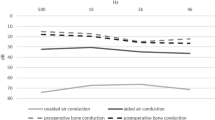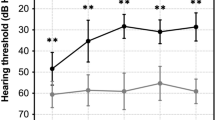Abstract
Purpose
To evaluate the audiological effectiveness of Bonebridge implantation in patients with bilateral congenital malformation of the external and middle ear.
Methods
Twenty-eight cases [17 boys and 11 girls; median age, 12 years (range 8–36 years)] had unilateral Bonebridge implantation. Audiological tests were performed preoperatively and postoperatively, and included the pure-tone audiometry test, speech discrimination score (SDS), and evaluation of the unaided and aided hearing thresholds in sound fields. For the group of patients aged > 12 years, Mandarin Speech Test Materials were used to determine the SDS. For the other cases, the Mandarin Lexical Neighborhood Test was used. The daily life efficacy was assessed using the Abbreviated Profile of Hearing Aid Benefit (APHAB) questionnaire postoperatively. The t and t′ tests were used in the statistical analyses.
Results
The hearing threshold with the Bonebridge improved by 25–35 dB HL, compared to that of the unaided condition. The SDS of patients aged > 12 years improved by about 50%; the SDS also improved by 10–20% in the three patients aged < 12 years. According to the APHAB, the mean Bonebridge scores of ease of communication, background noise, and reverberation decreased by 60.3 ± 15.7, 50.2 ± 11.1, and 59.4 ± 7.8, respectively, compared to the preoperative scores, and the Bonebridge score of aversiveness was higher (69.8 ± 10.8) than the unaided score.
Conclusions
The audiological effectiveness of the Bonebridge was significant and noticeable in bilateral congenital malformation of the external and middle ear. The Bonebridge can be an alternative and effective solution for those patients to improve hearing.




Similar content being viewed by others
References
Deng K, Dai L, Yi L, Deng C, Li X, Zhu J (2016) Epidemiologic characteristics and time trend in the prevalence of anotia and microtia in china. Birth Defects Res A 106(2):88–94
Teufert KB, Cruz ADL (2004) Advances in congenital aural atresia surgery: effects on outcome. Otolaryngol Head Neck Surg 131(3):263–270
Shonka DC Jr, Livingston WJ 3rd, Kesser BW (2008) The Jahrsdoerfer grading scale in surgery to repair congenital aural atresia. Arch Otolaryngol Head Neck Surg 134(8):873–877
Yeakley JW, Jahrsdoerfer RA (1996) Ct evaluation of congenital aural atresia: what the radiologist and surgeon need to know. J Comput Assist Tomogr 20(5):724–731
Lambert PR (1998) Congenital aural atresia: stability of surgical results. Laryngoscope 108(12):5
Zhao S, Wang D (2013) Long-term following-up of auricle reconstruction and auditory rehabilitation in patients with congenital dysplasias of the external and middle ear. J Clin Otorhinolaryngol Head Neck Surg 27(19):1045–1047
Jahrsdoerfer RA, Yeakley JW, Aguilar EA, Cole RR, Gray LC (1992) Grading system for the selection of patients with congenital aural atresia. Am J Otol 13(1):6–12
Köslinga S, Bartel-Friedrich S (2009) Congenital malformations of the external and middle ear. Eur J Radiol 69(2):269–279
Han D, Wang S, Zhang H, Chen J, Jiang W, Mannell R et al (2009) Development of Mandarin monosyllabic speech test materials in China. Int Audiol 48(5):300–311
Zhang H, Wang S, Wang L, Chen J, Chen AT, Guo LS et al (2006) Development and equivalence evaluation of spondee lists of mandarin speech test materials. Chin J Otorhinolaryngol Head Neck Surg 41(6):425
Kam ACS, Tong MCF, Hasselt AV (2011) Cross-cultural adaptation and validation of the Chinese abbreviated profile of hearing aid benefit. Int J Audiol 50(5):334–339
Cox RM, Alexander GC (1995) The abbreviated profile of hearing aid benefit. Ear Hear 16(2):176–186
Wang D, Zhao S, Zhao Y, Chen S, Yang L (2014) Congenital bifurcation of tympanic segment of facial nerve. Chin Med J 127(9):1788–1790
Zhao S, Wang D, Han D, Gong S, Ma X, Li Y et al (2012) Integrated protocol of auricle reconstruction combined with hearing reconstruction. Acta Otol Laryngol 132(8):829–833
Shih L, Crabtree JA (1993) Long-term surgical results for congenital aural atresia. Laryngoscope 103(10):1097–1102
De la Cruz A, Teufert KB (2003) Congenital aural atresia surgery: long-term results. Otolaryngol Head Neck Surg 129(1):121–127
Sprinzl G, Lenarz T, Ernst A, Hagen R, Wolf-Magele A, Mojallal H et al (2013) First European multicenter results with a new transcutaneous bone conduction hearing implant system: short-term safety and efficacy. Otol Neurotol 34(6):1076–1083
Tsang WS, Yu JK, Bhatia KS, Wong TK, Tong MC (2013) The Bonebridge semi-implantable bone conduction hearing device: experience in an Asian patient. J Laryngol Otol 127(12):1214–1221
Barbara M, Perotti M, Gioia B, Volpini L, Monini S (2013) Transcutaneous bone-conduction hearing device: audiological and surgical aspects in a first series of patients with mixed hearing loss. Acta Oto-Laryngol 133(10):1058–1064
Nelissen RC, Mylanus Emmanuel A M (2013) A new bone-anchored hearing implant: short-term retrospective data on implant survival and subjective benefit. Eur Arch Otorhinolaryngol 270(12):3019–3025
Schmerber S, Deguine O, Marx M, Van HP, Sterkers O, Mosnier I et al (2017) Safety and effectiveness of the Bonebridge transcutaneous active direct-drive bone-conduction hearing implant at 1-year device use. Eur Arch Oto-Rhino-Laryngol 274(4):1835–1851
Ratuszniak A, Skarzynski PH, Gos E, Skarzynski H (2018) The Bonebridge implant in older children and adolescents with mixed or conductive hearing loss: audiological outcomes. Int J Pediatr Otorhinolaryngol 118:97
Kulasegarah J, Burgess H, Neeff M, Brown C (2018) Comparing audiological outcomes between the Bonebridge and bone conduction hearing aid on a hard test band: our experience in children with atresia and microtia. Int J Pediatr Otorhinolaryngol 107:176–182
Carnevale C, Til-Pérez G, Arancibia-Tagle D, Tomás-Barberán Manuel, Sarría-Echegaray Pedro Luis (2018) Hearing outcomes of the active bone conduction system Bonebridge® in conductive or mixed hearing loss. Acta Otorrinolaringol Española 70(2):80–88
Funding
This study was funded by a grant that Shouqin Zhao received from the General Programs of Beijing Municipal Science and Technology Commission (Grant number: Z171100001017079).
Author information
Authors and Affiliations
Corresponding author
Ethics declarations
Conflict of interest
The authors declare that they have no conflict of interest.
Ethical approval
The institutional and/or national research committee and with the 1964 Helsinki Declaration and its later amendments or comparable ethical standards. The study design was approved by the Institutional Ethics Committee at Beijing Tongren Hospital.
Informed consent
All study participants provided informed consent.
Additional information
Publisher's Note
Springer Nature remains neutral with regard to jurisdictional claims in published maps and institutional affiliations.
Rights and permissions
About this article
Cite this article
Ren, R., Zhao, S., Wang, D. et al. Audiological effectiveness of Bonebridge implantation for bilateral congenital malformation of the external and middle ear. Eur Arch Otorhinolaryngol 276, 2755–2762 (2019). https://doi.org/10.1007/s00405-019-05533-2
Received:
Accepted:
Published:
Issue Date:
DOI: https://doi.org/10.1007/s00405-019-05533-2




